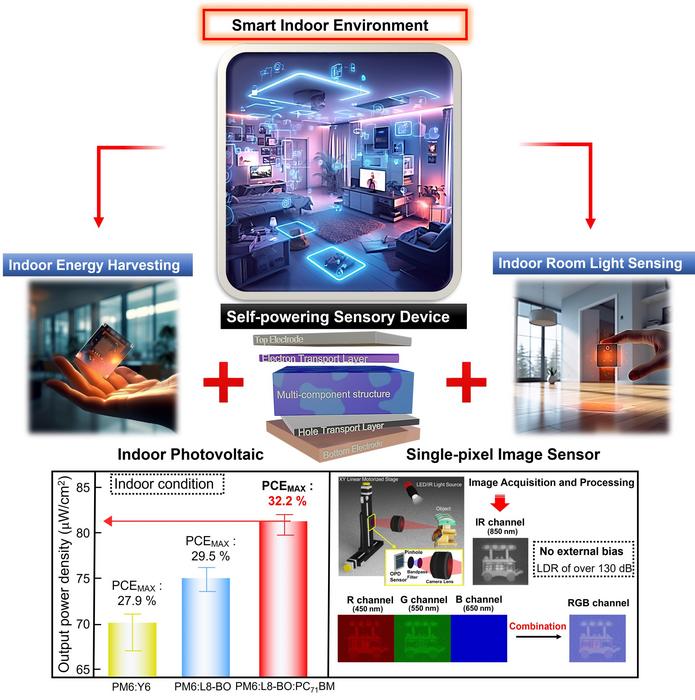| Jan 25, 2024 |
Advanced full-color image sensor technology enables simultaneous energy harvesting and imaging
(Nanowerk News) Organic-based optoelectronic technology is increasingly recognized as an energy-efficient solution for low-power indoor electronics and wireless IoT sensors. This is largely due to its superior flexibility and light weight compared to conventional silicon-based devices. Notably, organic photovoltaic cells (OPVs) and organic photodetectors (OPDs) are leading examples in this field.
|
|
OPVs have the remarkable ability to absorb energy and generate electricity even under very low light condition, while OPDs are capable of capturing images. However, despite their potential, the development of these devices has been conducted independently thus far. As a result, they have not yet reached the level of efficiency necessary to be considered practical for next-generation, miniaturized devices.
|
|
The Korea Institute of Science and Technology (KIST), led by Dr. Min-Chul Park and Dr. Do Kyung Hwang of the Center for Opto-Electronic Materials and Devices, Prof. Jae Won Shim and Prof. Tae Geun Kim of the School of Electrical Engineering at Korea University, Prof. JaeHong Park of the Department of Chemistry and Nanoscience at Ewha Womans University, have developed an organic-based optoelcectronic device (Advanced Materials, "Self-Powering Sensory Device with Multi-Spectrum Image Realization for Smart Indoor Environments").
|
 |
| Organics-based optoelectronic technology is gaining attention as an energy-efficient and environmentally friendly electronic device for Internet of Things (IoT)-based wireless sensors and low-power indoor electronics. Among them, organic photovoltaic (OPV) and organic photodetector (OPD) efficiently utilize ambient unutilized or low-light to generate electricity and detect light to implement images. Organic photovoltaics (OPVs) can be used to harvest indoor energy, while organic photodetectors (OPDs) can be used like cameras, utilizing indoor light for imaging as needed. (Image: Korea Institute of Science and Technology
|
|
This innovative device not only integrates the functionalities of organic photovoltaic cells (OPVs) and organic photodetectors (OPDs) but also pioneers in visualizing images in applications requiring low-light conditions, thereby enhancing energy efficiency in indoor environments.
|
|
By advancing the organic semiconductor layer into a multicomponent structure, the research team has enhanced the device's performance. In door environments, it achieves an impressive photoelectric conversion efficiency exceeding 32%, along with a linear dynamic range surpassing 130 dB. This significant improvement in contrast ratio, especially in low-light conditions, allows for a much clearer image than conventional silicon devices, which typically offer a linear dynamic range of 100 dB.
|
|
The collaborative research team made further strides by successfully applying single-pixel image sensing. This image sensing system capture ambient light, transforms into electrical energy, and utilize this energy to acquire images. In contrast to the previous need for specialized cameras in low-light of standard lighting conditions, the newly developed photodetector, featuring a multi-component semiconductor layer, offers a versatile application. It can function not only as a conventional camera but also as a decorative element on windows or walls, providing sufficient resolution to discern shapes and movements of objects.
|
|
Dr. Min-chul Park from KIST highlighted the versatility of this technology, noting, "While primarily functioning as an energy harvester, it can also be applied to detect movement and recognize motion patterns in environments without light." He further expressed optimism about its potential applications, stating, "This holds great promise not only for human-computer interaction (HCI) research but also in various industrial sectors, including smart indoor environments."
|

